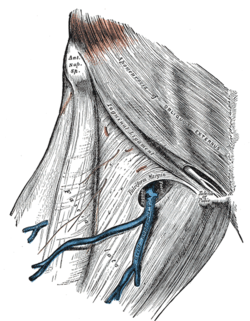Fascia lata
| Fascia lata | |
|---|---|

The fossa ovalis. (Fascia lata labeled at bottom left.)
|
|

Iliotibial tract.
|
|
| Details | |
| Identifiers | |
| Latin | Fascia lata |
| TA | A04.7.03.002 |
| FMA | 13902 |
|
Anatomical terminology
[]
|
|
The fascia lata is the deep fascia of the thigh. It encloses the thigh muscles and forms the outer limit of the fascial compartments of thigh, which are internally separated by . The fascia lata is thickened at its lateral side where it forms the iliotibial tract, a structure that runs to the tibia and serves as a site of muscle attachment.
The fascia lata is an investment for the whole of the thigh, but varies in thickness in different parts. It is thicker in the upper and lateral part of the thigh, where it receives a fibrous expansion from the gluteus maximus, and where the tensor fasciae latae is inserted between its layers; it is very thin behind and at the upper and medial part, where it covers the adductor muscles, and again becomes stronger around the knee, receiving fibrous expansions from the tendon of the biceps femoris laterally, from the sartorius medially, and from the quadriceps femoris in front.
The fascia lata surrounds the tensor fasciae latae muscle. It is a fibrous sheath that encircles the thigh subcutaneously. This encircling of the muscle allows the muscles to be bound together tightly.
The fascia lata is attached, above and behind (i.e. proximal and posterior), to the back of the sacrum and coccyx; laterally, to the iliac crest; in front, to the inguinal ligament, and to the superior ramus of the pubis; and medially, to the inferior ramus of the pubis, to the inferior ramus and tuberosity of the ischium, and to the lower border of the sacrotuberous ligament.
...
Wikipedia
